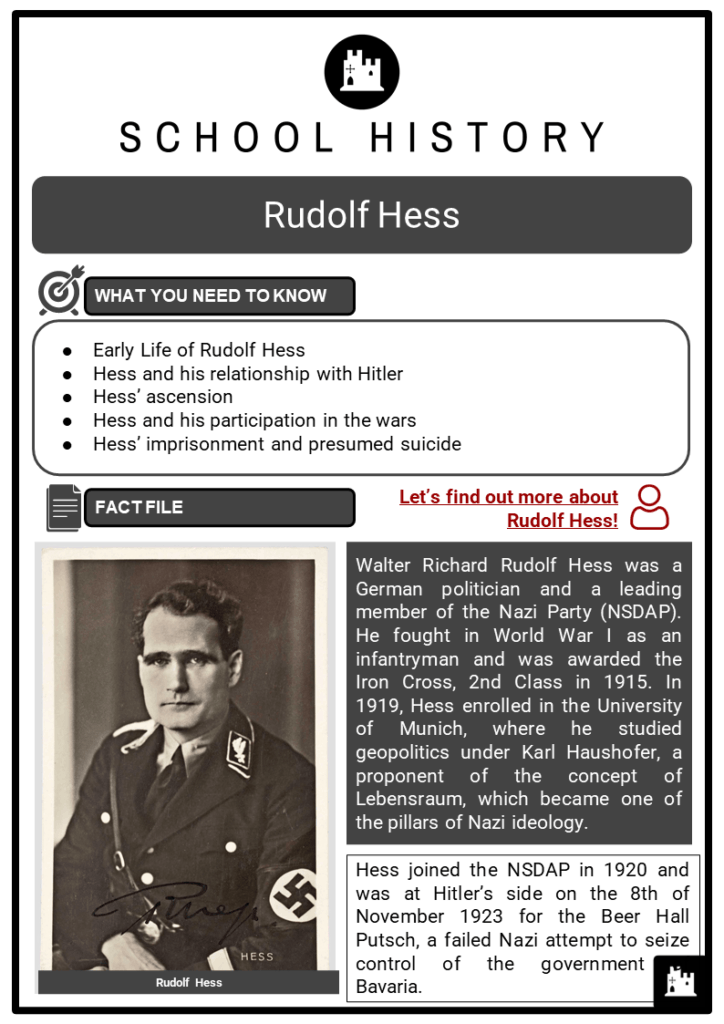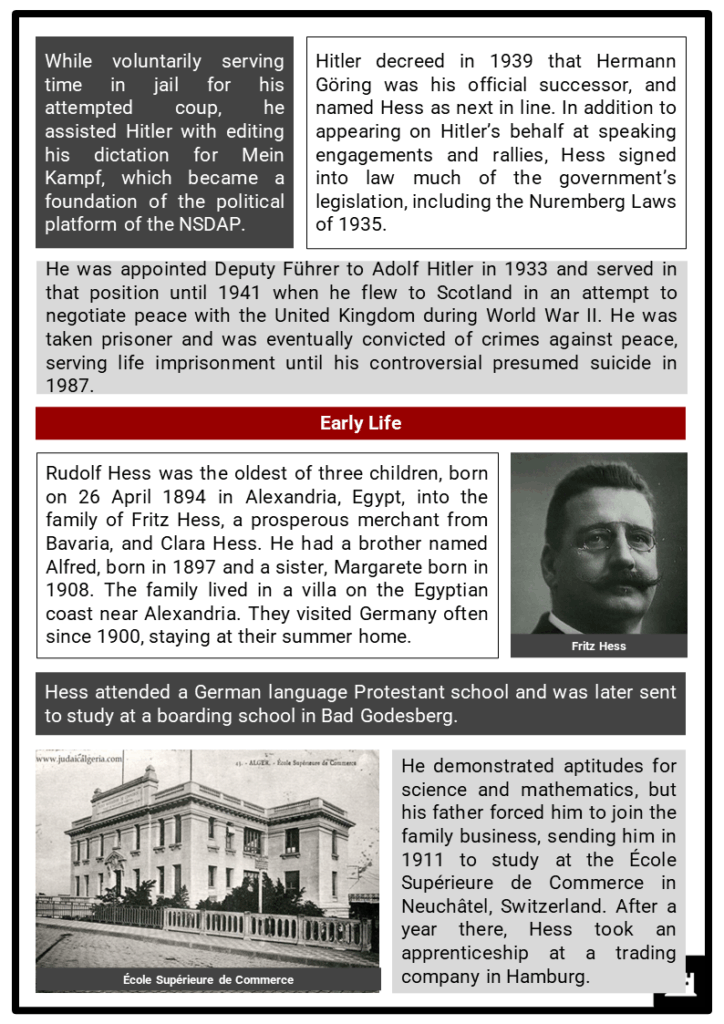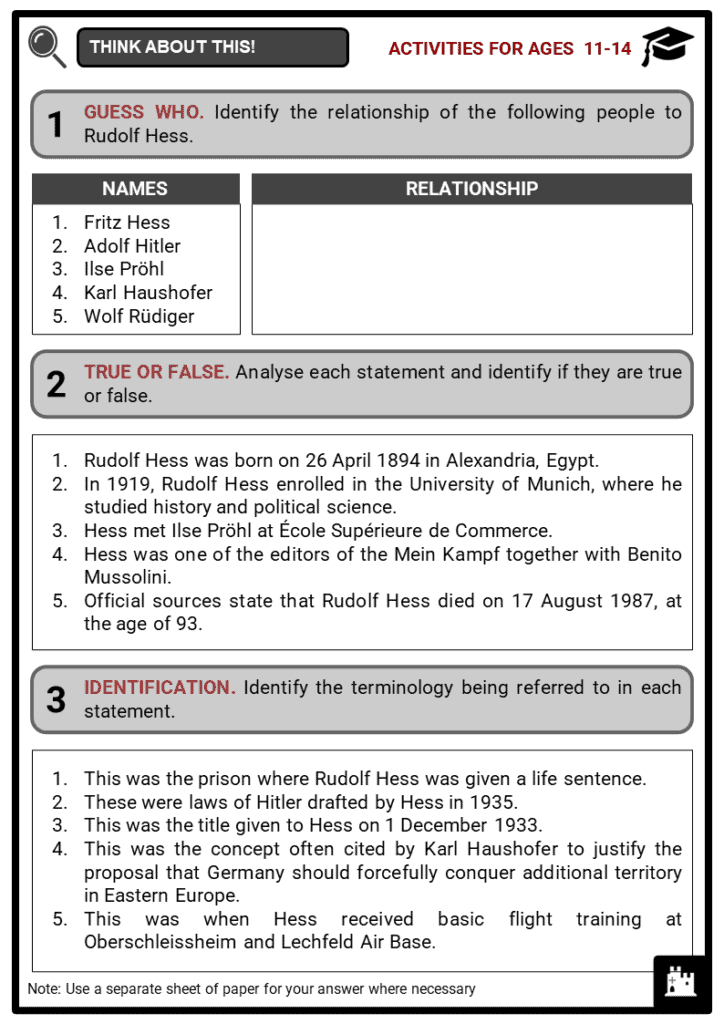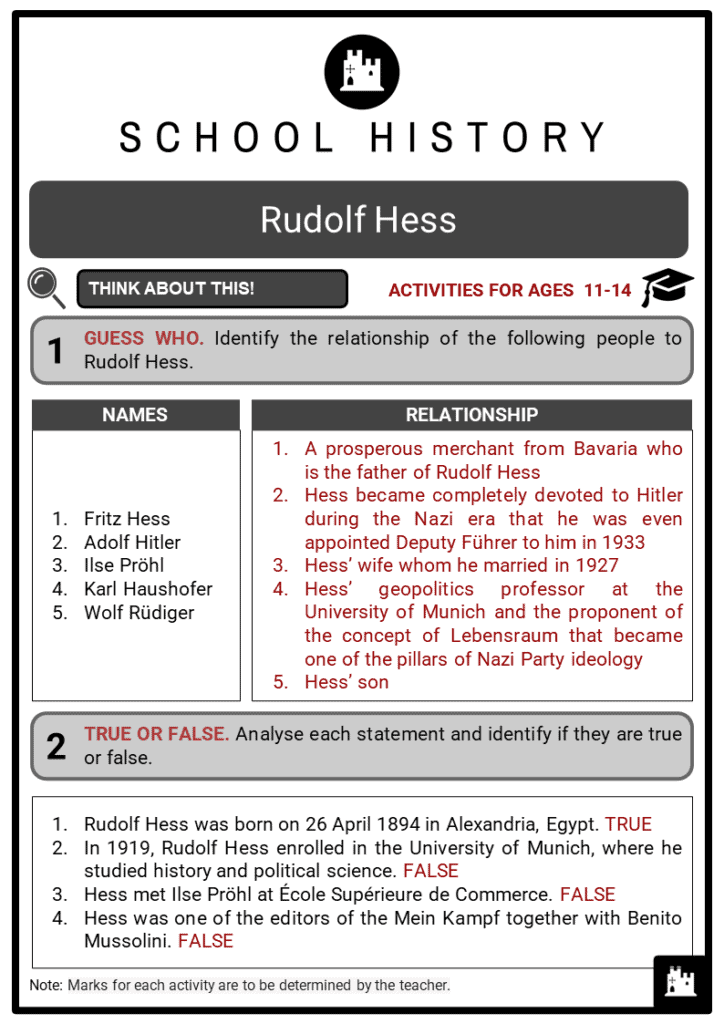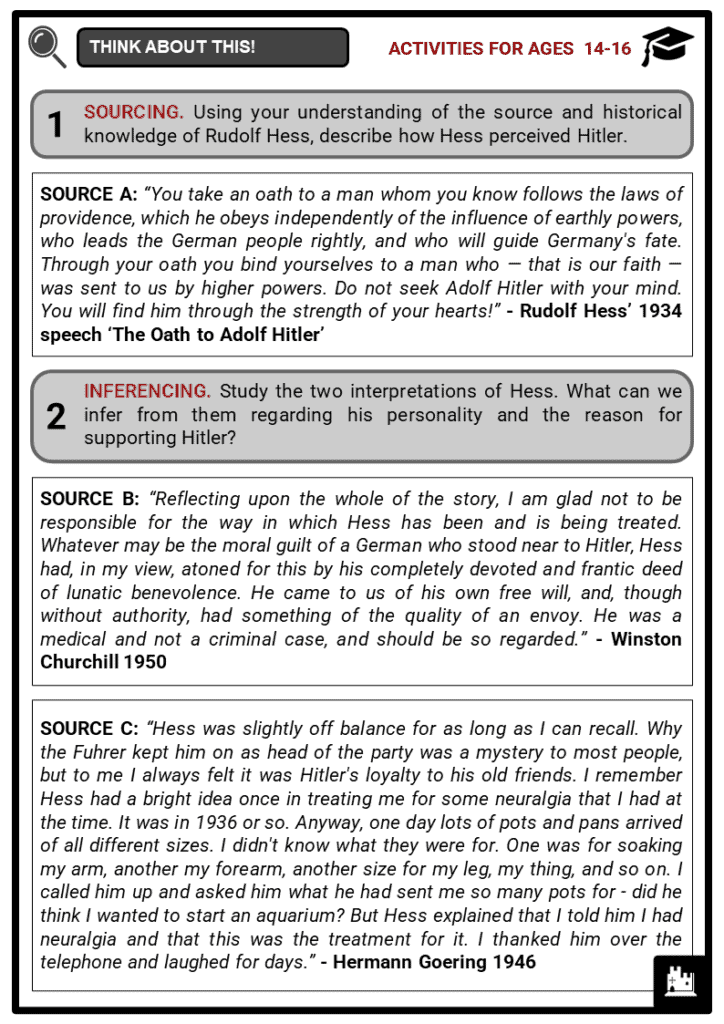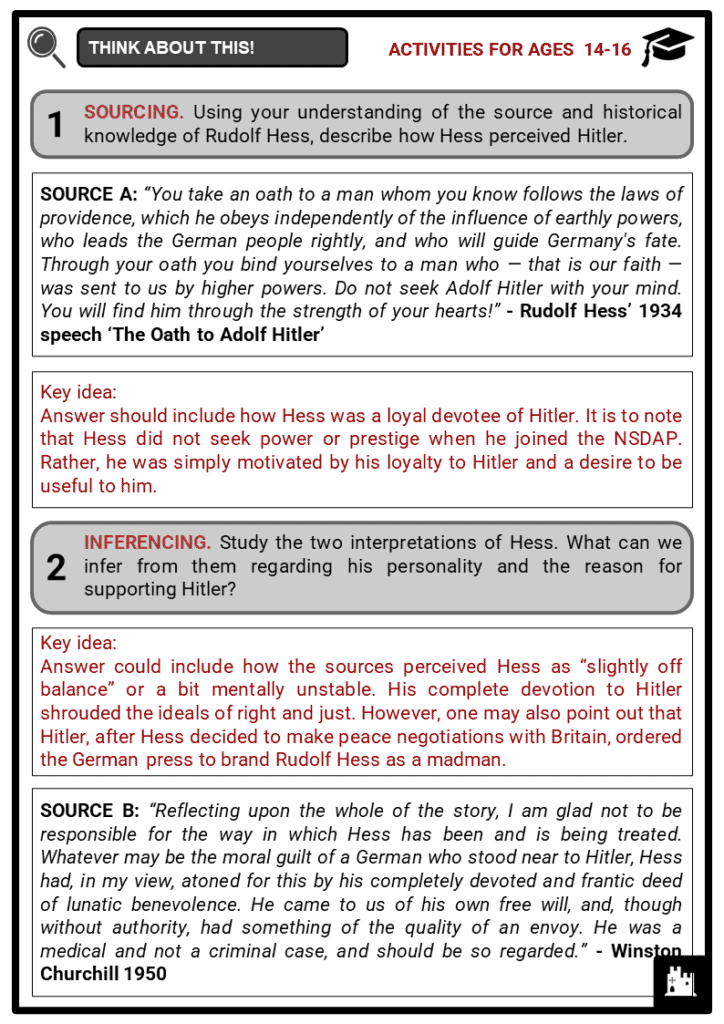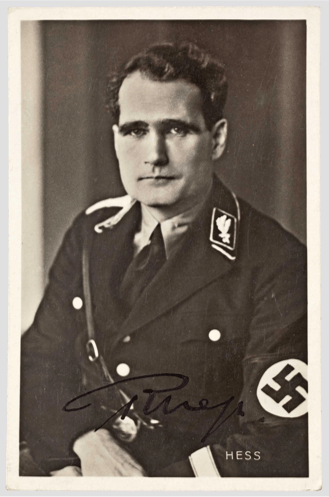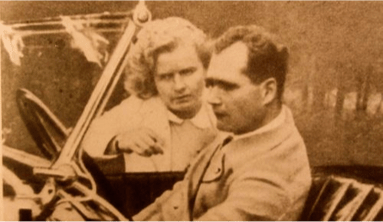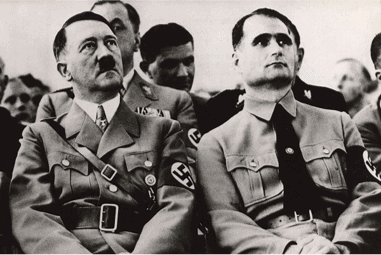Download Rudolf Hess Worksheets
Do you want to save dozens of hours in time? Get your evenings and weekends back? Be able to teach Rudolf Hess to your students?
Our worksheet bundle includes a fact file and printable worksheets and student activities. Perfect for both the classroom and homeschooling!
Table of Contents
Add a header to begin generating the table of contents
Summary
- Early Life of Rudolf Hess
- Hess and his relationship with Hitler
- Hess’ ascension
- Hess and his participation in the wars
- Hess’ imprisonment and presumed suicide
Key Facts And Information
Let’s find out more about Rudolf Hess!
- Walter Richard Rudolf Hess was a German politician and a leading member of the Nazi Party (NSDAP). He fought in World War I as an infantryman and was awarded the Iron Cross, 2nd Class in 1915. In 1919, Hess enrolled in the University of Munich, where he studied geopolitics under Karl Haushofer, a proponent of the concept of Lebensraum, which became one of the pillars of Nazi ideology.
- Hess joined the NSDAP in 1920 and was at Hitler’s side on the 8th of November 1923 for the Beer Hall Putsch, a failed Nazi attempt to seize control of the government of Bavaria.
- While voluntarily serving time in jail for his attempted coup, he assisted Hitler with editing his dictation for Mein Kampf, which became a foundation of the political platform of the NSDAP.
- Hitler decreed in 1939 that Hermann Göring was his official successor, and named Hess as next in line. In addition to appearing on Hitler’s behalf at speaking engagements and rallies, Hess signed into law much of the government’s legislation, including the Nuremberg Laws of 1935.
- He was appointed Deputy Führer to Adolf Hitler in 1933 and served in that position until 1941 when he flew to Scotland in an attempt to negotiate peace with the United Kingdom during World War II. He was taken prisoner and was eventually convicted of crimes against peace, serving life imprisonment until his controversial presumed suicide in 1987.
Early Life
- Rudolf Hess was the oldest of three children, born on 26 April 1894 in Alexandria, Egypt, into the family of Fritz Hess, a prosperous merchant from Bavaria, and Clara Hess. He had a brother named Alfred, born in 1897 and a sister, Margarete born in 1908. The family lived in a villa on the Egyptian coast near Alexandria. They visited Germany often since 1900, staying at their summer home.
- Hess attended a German language Protestant school and was later sent to study at a boarding school in Bad Godesberg.
- He demonstrated aptitudes for science and mathematics, but his father forced him to join the family business, sending him in 1911 to study at the École Supérieure de Commerce in Neuchâtel, Switzerland. After a year there, Hess took an apprenticeship at a trading company in Hamburg.
Rudolf Hess
- Hess enlisted in the 7th Bavarian Field Artillery Regiment in the beginning of World War I. He was present at the First Battle of Ypres. On the 9th of November 1914, Hess transferred to the 1st Infantry Regiment, stationed near Arras. After suffering a couple of wounds, he was awarded the Iron Cross, second class, and promoted to corporal in April of 1515. After additional training, he was promoted to senior non-commissioned officer and received the Bavarian Military Merit Cross.
- Hess was two months out of action due to a throat infection. After he recovered, he served at the Battle of Verdun in May and was hit in the left hand and arm on the 12th of June 1916, while fighting near the village of Thiaumont. After a month off for recovery, he was sent back to the Verdun area where he remained there until December. Hess was again promoted, this time as platoon leader of the 10th Company of the 18th Bavarian Reserve Infantry Regiment, which was serving in Romania.
- He suffered numerous wounds until 1917, some of them included a bullet wound that entered the upper chest near the armpit and exited near his spinal column, leaving a pea-sized entry wound and a stone sized exit wound on his back. By 20th of August, he was well enough to at least travel, and he went to the hospital in Meissen, Germany.
- In October, he received a promotion to Leutnant der Reserve, and was recommended for, but did not receive, the Iron Cross, first class. His father requested that he be transferred to a hospital closer to home.
- Hess interestingly requested that he be allowed to enrol to train as a pilot, so after some Christmas leave with his family, he reported to Munich. He received basic flight training at Oberschleissheim and Lechfeld Air Base in March to June 1918. On 11 November 1918, the war ended.
Ascension
- Though the war had ended, its aftermath was felt in Germany. Hess’ family was affected by this - the fortunes had taken a serious downturn, as their business interests in Egypt had been expropriated by the British. Hess joined the Thule Society, a right-wing Völkisch group, and the Freikorps of colonel Ritter von Epp, one of many such volunteer paramilitary organizations active in Germany at the time.
- In 1919, he enrolled in the University of Munich, where he studied history and economics. His geopolitics professor was Karl Haushofer, a former general in the German Army who was a proponent of the concept of Lebensraum. Haushofer often cited the Lebensraum to justify the proposal that Germany should forcefully conquer additional territory in Eastern Europe. Hess later introduced this concept to Adolf Hitler, and it became one of the pillars of Nazi Party ideology.
- Hess met Ilse Pröhl, a fellow student at the university in April 1920. They married in 1927 and had a son in 1937 named Wolf Rüdiger Hess. This name, at least in part, was to honour Hitler, who often used “Wolf” as a codename.
- Hess would instantly be drawn to Hitler since 1920, after hearing him speak for the first time at a Munich rally. Hess became completely devoted to him. They held a shared belief in the stab-in-the-back myth: the notion that Germany’s loss in World War I was caused by a conspiracy of Jews and Bolsheviks. He quickly joined the NSDAP.
- The party continued to grow, with rallies and meetings taking place in larger and larger beer halls in Munich. Hess focused on fundraising and organizational activities. A bomb later exploded at Hofbraühaus during a party event on the 4th of November 1921.
- It was said to be planted by a Marxist group. During the incident, Hess was wounded while protecting Hitler. This would earn him even more respect, both from Hitler and others. He would go on and join the Sturmabteilung, or SA, in 1922.
- Meanwhile, hyperinflation caused many personal fortunes to be rendered worthless. Germany failed to meet its reparations payment to France, and France’s troops began to march in to occupy the industrial areas along the Ruhr in 1923. This caused massive civil unrest and prompted Hitler to decide that the time was ripe to seize control of the government - a coup modelled on Benito Mussolini’s 1922 March on Rome.
- Hess was with Hitler in 1923, when they stormed in the Bürgerbraükeller, interrupting Gustav von Kahr’s speech and announcing that the national revolution had begun. Hitler also had the support of World War I General Erich Ludendorff. However, when they marched on to the Ministry of War, gunfire broke out with the police, leaving twenty people dead. Hitler and Hess were arrested and the NSDAP, together with the SA, were outlawed.
- This is when Hitler began to work on his memoir, Mein Kampf, in the Landsberg Prison. He dictated Mein Kampf to fellow prisoners Hess and Emil Maurice. It was later edited by them and published in two parts: the first in 1925 and the second in 1926.
- Later, it was released in a single volume and became a bestseller after 1930. The book became the foundation of the political platform of the NSDAP.
- Hess and Hitler were very close, travelling together around the country promoting their ideals, and in 1932, Hess was named party Political Central Commissioner. Hess retained his interest in flying and managed to get a license. He dedicated many flying hours and became proficient in the operation of light single-engine aircrafts.
World War II
- Hitler was appointed Reich Chancellor in 1933, which was the first step in gaining dictatorial control over Germany. Hess was named Deputy Führer with the post of Reich Minister without Portfolio, on 1 December. He was responsible for several departments including foreign affairs, finance, health, education, and law. This meant that all legislation would pass through his office, with the exceptions of the ones concerning the army.
- He was an organiser of the Nuremberg Rallies, usually giving the opening speech and introducing Hitler. Hess also spoke over the radio and at rallies across the country. He acted as a delegate in negotiations with industrialists and members of the wealthier families. He was given the rank of Obergruppenführer in the SS in 1934. This was the second-highest SS rank. Shortly after the Nazi regime came to power, they began to persecute Jews, and Hess was responsible for drafting Hitler’s Nuremberg Laws of 1935.
- His friend Karl Haushofer and his family were subject to these laws, as Haushofer had married a half-Jewish woman. Hess thus issued documents exempting them from this legislation.
- Hess did not seek power or prestige, he was simply motivated by his loyalty to Hitler and a desire to be useful to him. He lived in a modest house in Munich. Although he had less influence than other top NSDAP officials, Hess was popular with the masses. After the start of World War II, Hitler made Hess second in line to succeed him, after Hermann Göring.
- The war caught up much of Hitler’s attention, leaving Hess sidelined due to the fact that he was not directly engaged in these endeavours. Bormann had supplanted Hess in many of his duties and thus usurped his position at Hitler’s side. This, coupled with the concern that Germany would fight on two fronts as plans progressed for Operation Barbarossa, forced Hess to take action. He thought of bringing Britain to the negotiating table by travelling there. He asked for advice from his friend and former teacher Albrecht Haushofer.
- Haushofer suggested several potential contacts in Britain. Hess settled and decided to talk to D. Douglas Hamilton, a fellow aviator and the Duke of Hamilton, a man whom he had never met. Hamilton was chosen because of the mistaken belief that he was one of the leaders of the opposition party opposed to war with Germany.
- In spite of not receiving a reply from Hamilton, Hess proceeded with his plan and began training on the Messerschmitt Bf 110. He took off on 10 May 1941. He remained largely undetected by British forces, but was still discovered. Although intercepting forces were sent to find him, he evaded them and disappeared again. Though he was once again detected, he remained low and was forced to parachute himself out of the plane.
- Before his departure, he had given a letter to his adjutant Karlheinz Pintsch, which was addressed to Hitler and detailed his intentions to open peace negotiations with the British. Hitler was worried that his allies, Italy and Japan, would perceive Hess’ act as an attempt to secretly open peace negotiations.
- For this reason, he ordered the German press to brand Rudolf Hess as a madman. However, Göring and Propaganda Minister Joseph Goebbels believed this only made matters worse. If Hess was truly mentally ill, it would reflect badly on them since he held a very important position in the government.
Imprisonment
- Hess landed by parachute in Scotland and was apprehended by the authorities. For a time, he lied about his name, but shortly after he confessed who he was and started stating he had come with peace proposals. Hess’ proposals met with no response from the British government, which treated him as a prisoner of war and held him throughout World War II. When the war was over, Hess went to court for the Nuremberg War crimes trial. In 1946, he was convicted and given a life sentence.
- He served his sentence at Spandau prison in Berlin, the prison controlled by the Allied Control Council which consisted of Britain, France, the Soviet Union, and the United States. Each country supplied prison guards for a month at a time on a rotating basis. Initially, he had six other inmates as companions who were also former Nazis.
- As time went by, however, one by one the six other inmates were released, either having served their sentence or released early because of ill health. Hess remained the only prisoner for 21 years in a prison designed to hold 600 people. He was permitted to write 1 letter a month and also receive 1 letter a month.
Death
- Official sources state that Rudolf Hess died on 17 August 1987, at the age of 93. The official description: “He took an extension cord from one of the lamps, strung it over a window latch, and hanged himself. A short note to his family was found in his pocket, thanking them for all that they had done.”
- It appeared that Rudolf Hess had killed himself, yet his lawyer Alfred Seidl felt that he was too old and frail to do so. What is rather unusual is the fact that he had done this at such an old age. His son even claimed that he was murdered.
- In 2012, a report by the historian Peter Padfield stated that the suicide note found on the body appeared to have been written when Hess was hospitalized in 1969. The Spandau prison was quickly demolished in the same year that Hess died.
Image sources:

